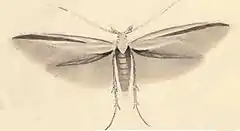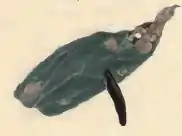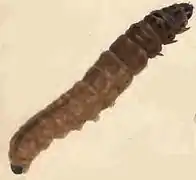Coleophora conspicuella
Coleophora conspicuella is a moth of the family Coleophoridae found in Asia and Europe. It was first described by Philipp Christoph Zeller in 1849.
| Coleophora conspicuella | |
|---|---|
 | |
| Coleophora cf. conspicuella | |
| Scientific classification | |
| Domain: | Eukaryota |
| Kingdom: | Animalia |
| Phylum: | Arthropoda |
| Class: | Insecta |
| Order: | Lepidoptera |
| Family: | Coleophoridae |
| Genus: | Coleophora |
| Species: | C. conspicuella |
| Binomial name | |
| Coleophora conspicuella Zeller, 1849 | |
Distribution and habitat
This species can be found in all of Europe (except Ireland), in Siberia, Asia Minor, Syria, Iraq and Altai.[1][2] These rather vulnerable moths mainly occur in field edges, grassy slopes and scrubland.
Description
In Coleophora conspicuella the wingspan can reach 13–17.5 mm.[3] Forewings of these moths have pale yellow ground colour, with pale streaks and white subcostal stripes, without oblique streaks to costa. Antennae are white, unringed and the scape shows a long tuft.[4]
Biology
The larvae mine leaves and feed on Aster amellus, Aster linosyris, Aster sedifolius, Aster sedifolius canus, Centaurea aspera, Centaurea jacea, Centaurea montana, Centaurea nigra, Centaurea scabiosa and Chrysanthemum species.[2][3][5]
They create and live within a movable relatively large, dark brown, lightly curved two-valved sheath case with a narrow ventral keel. It is about 12–15 mm long and has a mouth angle of 30-45°.[5] Full-grown larvae can be found in May.[5]
Gallery
 Mounted specimen
Mounted specimen Mined piece of leaf of Centaurea nigra with a larva-case attached
Mined piece of leaf of Centaurea nigra with a larva-case attached Larva
Larva
References
- "Coleophora conspicuella Zeller, 1849". Fauna Europaea. Retrieved 1 January 2020.
- Funet - Markku Savela's Lepidoptera and some other life forms
- "Coleophora conspicuella (Zeller, 1849)". Microlepidoptera.nl. Retrieved 1 January 2020.
- "Key to Copeophora species". British Lepidoptera. Retrieved 1 January 2020.
- Ellis, W N. "Coleophora conspicuella Zeller, 1849 knapweed case-bearer". Plant Parasites of Europe. Retrieved 1 January 2020.